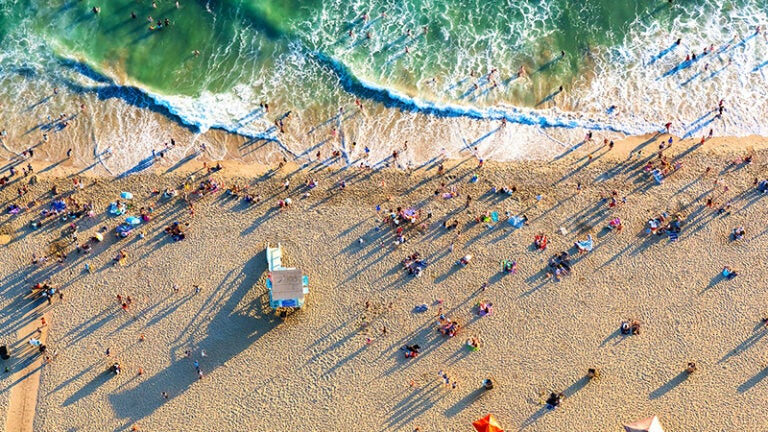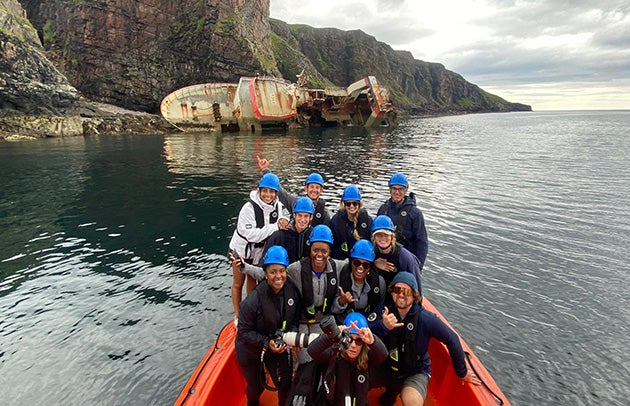
USC Sea Grant celebrates 50 years, leads new efforts to assess impact of toxic pesticide DDT in ocean near LA
In brief:
USC Sea Grant has been supporting research and providing expertise to industries to help keep our urban ocean healthy since 1972.
They also provide educational opportunities to kids and college students to foster the next generation of ocean stewards.
Now, they’re working to determine how a recently discovered accumulation of the pesticide DDT could harm the ocean — and how to mitigate its effects.
In 2020, some 800,000 pounds of the pesticide DDT were discovered on the ocean floor near Santa Catalina Island, off the coast of Southern California. The toxic accumulation is the result of industrial dumping of, on average, 40,000 pounds annually from the 1940s to the ’60s.
DDT is probably most famed for its central place in Rachel Carson’s ground-breaking novel Silent Spring, which chronicled the substance’s disastrous effects on wildlife. The book galvanized the United States to ban the substance and to create the Environmental Protection Agency (EPA) in the 1970s.
The EPA has known about DDT in Southern California waters for decades. In the 1990s, the agency designated 17 square miles of the Rancho Palos Verdes coastline a Superfund site due to contamination from the substance. However, recent research has revealed that the geographic extent and quantity of the pollution are much greater than once believed.
USC Sea Grant, part of the USC Dornsife College of Letters, Arts and Sciences, explains this complicated history in their 2023 report, called a story map, on the topic.
Figuring out how the DDT might impact the ocean and if there is any way to mitigate its effects is now crucial, and USC Sea Grant has 50 years of experience in just this sort of problem.
“We have an exceptional network of scientists, community leaders, on-the-ground workforce and government representatives at national, regional, state and local levels,” says Karla Heidelberg, director of the program and professor of the practice of biological sciences and environmental studies at USC Dornsife. “This and our in-depth knowledge of the region give us a unique ability to generate timely, practical solutions to real problems in real places, like the current issue with DDT.”
Formed in 1972, USC Sea Grant is part of a system of university-based Sea Grant programs focused on America’s coasts and Great Lakes, funded by the National Oceanic and Atmospheric Administration.
It’s celebrating five decades of ocean and coastal research, community outreach and education, while also taking on one of its biggest challenges to date.
USC Sea Grant helps fish and fishermen
Inspired by USC’s Los Angeles location, where waves crash to shore on the nation’s second-largest metropolitan area, USC Sea Grant makes the “urban ocean” the focus of its mission. Since its start, the program has funded research into issues that affect ports, porpoises and people alike.
“Before my time, back in the ’70s, the program looked at the environmental impact of the ports,” says Linda Duguay, who served as director of USC Sea Grant from 1999 to 2022 and is associate professor (research) of biological sciences at USC Dornsife. “At one point, the tuna canneries were there, too, and there were a lot of toxins. We did a lot of research early on into what was happening in the port, and we can now say that the ports are much cleaner than they were.”

In the years since, USC Sea Grant has worked closely with the Port of Los Angeles and the Port of Long Beach — the largest port complex in the nation — to improve air quality in the basin, reduce the number of ship strikes on migrating whales and develop a new space for collaborative marine research.
They recently helped open AltaSea in a building owned by the Port of L.A. More than 20 colleges and universities use the space for scientific collaboration and business innovation. USC Dornsife researchers use the space to develop more resilient mussels, oysters and kelp.
Other research has examined the impact of sewage disposal plants and storm-produced wastewater on the ocean, harmful algal blooms, beach erosion and the health of California’s kelp forests.
In 1999, thanks in part to the help of USC Sea Grant, California passed the Marine Life Protection Act. The act established 124 Marine Protected Areas (MPAs) across the state and enabled the state to conserve key areas while also allowing fishing boats to continue harvesting.
Aquaculture has also been a focus for the program. Farming seafood can provide healthy protein to Californians without leaning too much on ocean stocks. USC Sea Grant led research on self-cleaning tanks that could make these set-ups more productive. They’re also helping to build enthusiasm for, and equitable access to, more sustainable seafood options like mussels in urban communities.
Ocean research program helps cities avoid catastrophe
In addition to supporting wildlife and industry, USC Sea Grant is preparing cities to cope with climate change, including rising sea levels. As ice caps melt, California’s coasts could see an increase of as much as six inches by 2033. Combined with more severe weather events, coastal urban areas are facing potentially catastrophic flooding and erosion.
Through their Regional AdaptLA initiative over the last decade, USC Sea Grant has provided scientific models, expertise and training to coastal practitioners, professionals who work in fields related to the management, conservation and development of coastal areas. Participants came from more than 20 coastal municipalities and learned to integrate climate change considerations into city and county planning.

USC Dornsife program connects a new generation with the coast
USC Sea Grant has an eye on future coastal leaders, too. Their educational programs have introduced thousands of young people to the ocean’s wonders and readied many for a career in the marine sciences.
During the COVID-19 closures, USC Sea Grant helped found the LA Stem Collective, which brought virtual science lessons to Los Angeles Unified School District students. Other programs use hands-on education and community-based science to bring experiences to students and families.
USC Sea Grant has also placed more than 100 graduate students in governmental, academic or nongovernmental fellowships to help the agencies and to learn about careers in coastal and resource management.
USC Sea Grant takes on DDT, and another 50 years
With another 50 years on the horizon, USC Sea Grant is facing a fresh challenge: helping California figure out what research is needed to address the impact of the deep-sea DDT. Their first step was to produce the story map outlining immediate action steps as well as a comprehensive list of what further research is needed.
“This assessment report is just the beginning. Working with our state and national partners, we’ll continue to provide leadership that supports DDT research to help us learn how to best address and mitigate this problem,” says Heidelberg.
They’ve recently partnered with California’s State Water Board and the University of California-based Sea Grant program to launch a call for research proposals that will fund up to $5.2 million in projects focused on California’s deep ocean and DDT.
Duguay has seen considerable change in her decades working in the industry, so she’s optimistic. “I’ve seen dramatic improvements in the health and safety of the environment over time, and hopefully it just keeps continuing,” she says.
